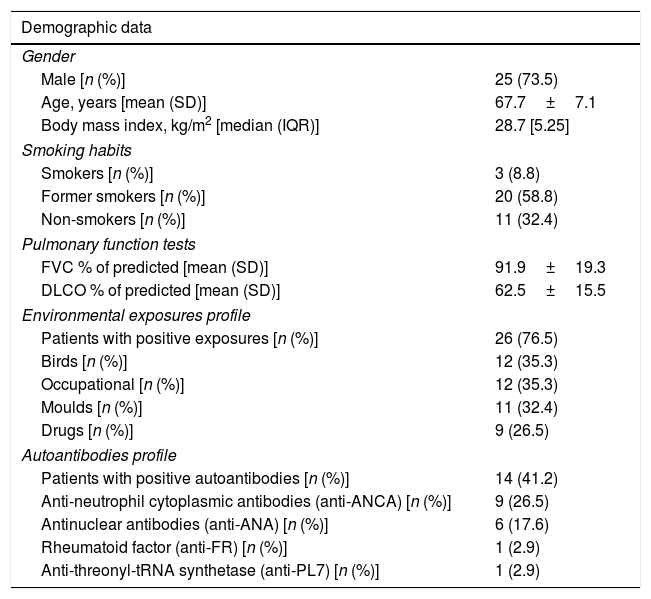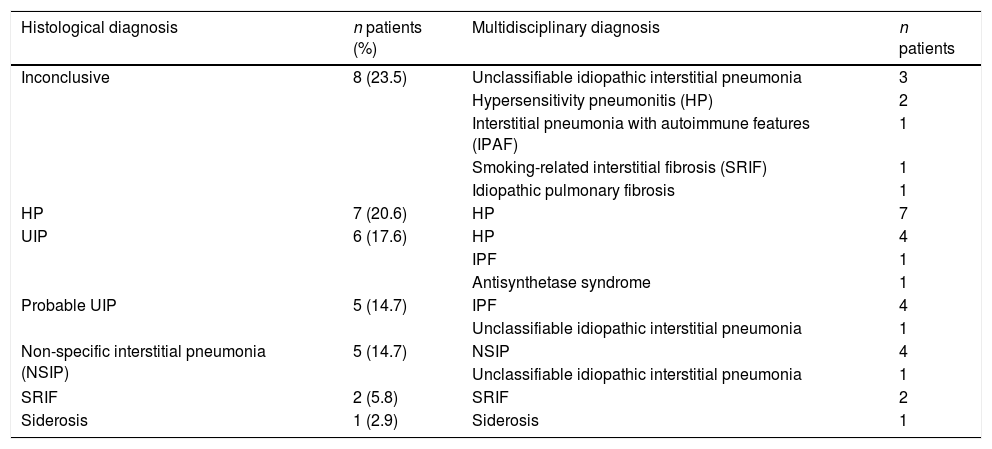In November 2017, Fleischner Society published a White Paper proposing four new diagnostic categories of UIP based on HRCT patterns.1 These HRCT patterns have been incorporated into the most recent clinical guidelines about diagnosis of IPF.2
The Fleischner Society White Paper also proposed that a typical or probable UIP pattern in HRCT provides a diagnosis of IPF in the appropriate clinical context and, in these cases, lung biopsy is not necessary.1 However, the 2018 guidelines about IPF diagnosis suggest surgical lung biopsy for patients who are clinically suspected of having IPF and have an HRCT pattern of probable UIP.2 Neither of the papers recommends transbronchial lung cryobiopsy (TBLC) for histological characterization.1,2
The aim of this study was to evaluate the histological and multidisciplinary diagnosis in patients with probable UIP pattern who underwent TBLC.
We reviewed HRCT of all patients who underwent TBLC between July 2014 and August 2017 at the Bronchoscopy Unit of the Pulmonology Department of Vila Nova de Gaia-Espinho Hospital Center. From a pool of 130 TBLC patients we only included those with probable UIP pattern, according to the Fleischner Society White Paper. Medical records, clinical and demographic data, histological and multidisciplinary diagnosis were retrospectively reviewed.
As a result we included 34 patients with probable UIP pattern, mostly male (n=25; 73.5%), with a mean age of 67.7±7.1 years old. Demographic data, smoking habits, pulmonary function tests, environmental exposures and autoantibodies profile are described in Table 1.
Patient characteristics.
| Demographic data | |
|---|---|
| Gender | |
| Male [n (%)] | 25 (73.5) |
| Age, years [mean (SD)] | 67.7±7.1 |
| Body mass index, kg/m2 [median (IQR)] | 28.7 [5.25] |
| Smoking habits | |
| Smokers [n (%)] | 3 (8.8) |
| Former smokers [n (%)] | 20 (58.8) |
| Non-smokers [n (%)] | 11 (32.4) |
| Pulmonary function tests | |
| FVC % of predicted [mean (SD)] | 91.9±19.3 |
| DLCO % of predicted [mean (SD)] | 62.5±15.5 |
| Environmental exposures profile | |
| Patients with positive exposures [n (%)] | 26 (76.5) |
| Birds [n (%)] | 12 (35.3) |
| Occupational [n (%)] | 12 (35.3) |
| Moulds [n (%)] | 11 (32.4) |
| Drugs [n (%)] | 9 (26.5) |
| Autoantibodies profile | |
| Patients with positive autoantibodies [n (%)] | 14 (41.2) |
| Anti-neutrophil cytoplasmic antibodies (anti-ANCA) [n (%)] | 9 (26.5) |
| Antinuclear antibodies (anti-ANA) [n (%)] | 6 (17.6) |
| Rheumatoid factor (anti-FR) [n (%)] | 1 (2.9) |
| Anti-threonyl-tRNA synthetase (anti-PL7) [n (%)] | 1 (2.9) |
Subtitles: SD – standard deviation; IQR – interquartile range; FVC – forced vital capacity; DLCO – diffusing capacity for carbon monoxide.
A bronchoalveolar lavage (BAL) was performed on all patients and, from the 26 patients with history of environmental exposures, only 7 had lymphocytosis ≥30% on cellular analysis of BAL fluid.
The histological and multidisciplinary diagnosis was described in Table 2.
Histological and multidisciplinary diagnosis.
| Histological diagnosis | n patients (%) | Multidisciplinary diagnosis | n patients |
|---|---|---|---|
| Inconclusive | 8 (23.5) | Unclassifiable idiopathic interstitial pneumonia | 3 |
| Hypersensitivity pneumonitis (HP) | 2 | ||
| Interstitial pneumonia with autoimmune features (IPAF) | 1 | ||
| Smoking-related interstitial fibrosis (SRIF) | 1 | ||
| Idiopathic pulmonary fibrosis | 1 | ||
| HP | 7 (20.6) | HP | 7 |
| UIP | 6 (17.6) | HP | 4 |
| IPF | 1 | ||
| Antisynthetase syndrome | 1 | ||
| Probable UIP | 5 (14.7) | IPF | 4 |
| Unclassifiable idiopathic interstitial pneumonia | 1 | ||
| Non-specific interstitial pneumonia (NSIP) | 5 (14.7) | NSIP | 4 |
| Unclassifiable idiopathic interstitial pneumonia | 1 | ||
| SRIF | 2 (5.8) | SRIF | 2 |
| Siderosis | 1 (2.9) | Siderosis | 1 |
Surgical lung biopsy was performed on 3 patients who had an inconclusive histological diagnosis. After surgical lung biopsy the histological and multidisciplinary diagnosis was HP (n=1), IPAF (n=1) and IPF (n=1).
In our study, from a group of patients who had TBLC, with probable UIP pattern in HRCT, a final multidisciplinary diagnosis of HP was reached for 38.2%, greater than the percentage of IPF (17.6%).
Different studies in Europe report IPF as a more frequent diagnosis than HP.3 There are no studies about HP prevalence in Portugal. The high percentage of HP in our study may reflect the high prevalence of exposures with clinical significance when a careful clinical history is carried out. In our population, 76.5% of patients had at least one relevant exposure. We suggest that in Portugal we have more clinically significant exposures, both occupational and recreational. In the past there was a strong Portuguese mining industry; this industry is still present.4 In 2014, the principal mineral commodities produced in Portugal included gypsum, lithium, ornamental stone, salt, silver, talc, tungsten, zinc and cooper. Nowadays, many jobs connected to agriculture and industry involve exposure to materials like cork, silica, and others, which may induce interstitial lung diseases (ILD). In Portugal, there are also many bird owners, like pigeon fanciers. The Portuguese Racing Pigeons Federation registered more than 18,000 pigeon fanciers, and an estimated 4.5 million racing pigeons.5 Therefore, if a careful clinical history is taken it is common to identify at least one significant exposure. This can make the differential diagnosis between IPF and HP even more difficult, and in some cases the patients may be misdiagnosed.
The Fleischer Society White Paper and IPF guidelines assumes surgical biopsy as gold standard for histological diagnosis of IPF, but TBLC is increasingly used, with diagnostic yield that ranges 50.6%–100%,6 and lower mortality due to adverse effects.6 In addition, TBLC may provide histological characterization in patients who would be refused for surgical lung biopsy due to age, comorbidities or severity of pulmonary disease.7
There are some limitations to our study: it is a retrospective study, with a small number of patients from a single centre. This could limit the interpretation of the results.
In conclusion we want to highlight the fact that in our sample of patients with probable UIP pattern, IPF diagnosis only accounted for 17.6% of cases, about half the cases of HP (38.2%). Our findings contrast with others from different populations and suggest that HP may be a very prevalent ILD in Portugal. Population-based studies and registries are urgently needed in order to properly understand the epidemiology of ILD in Portugal.
We also want to emphasize, that in patients with probable UIP pattern, 76.5% of patients had at least one exposure identified, and it is often difficult to assess whether these exposures are clinically relevant or not. Although TBLC is not a gold standard in ILD evaluation, is a safe procedure that provides histological characterization for patients who would be refused surgical lung biopsy, so we think that TBLC should be considered when approaching patients with probable UIP pattern.
Conflicts of interestThe authors have no conflicts of interest to declare.









